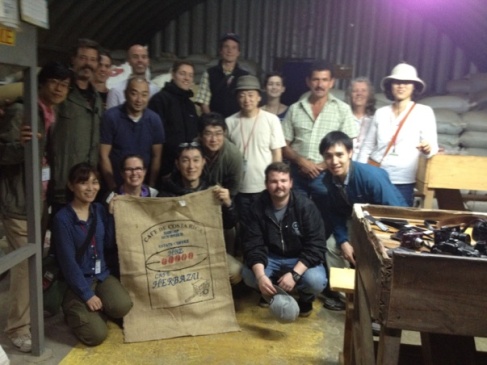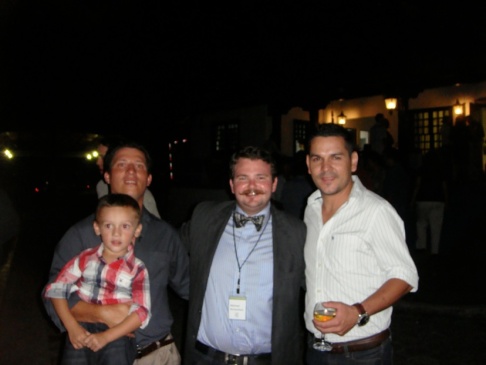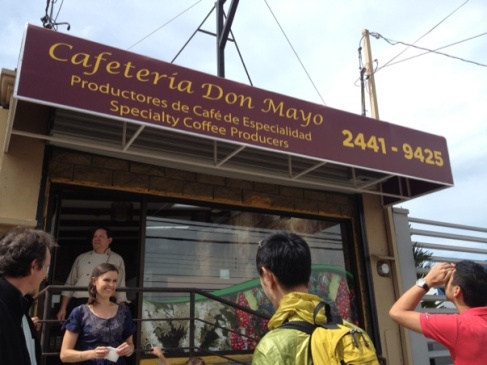Our Blog

2012 Trips to Origin: Mike’s adventures in Costa Rica – a first person account
Mike Richardson has been with Kean Coffee since our doors first opened in late 2005, first as a barista, then becoming a manager and barista trainer. Mike is passionate about coffee and about what he does, and has participated in several barista competitions- three times competing in the Western Regional Barista Competition and the Ultimate Barista Competition, and once judging the WRBC. Below is his fascinating account of the trip to Costa Rica he went on this past April along with our roaster Ted Vautrinot, who was invited to judge for Costa Rica Cup of Excellence. Enjoy!
Everyone has been asking me what I did in Costa Rica. Where do I begin?
Well the first full day was amazing. I was introduced to the Cup Of Excellence (COE) program where they take the top 38 coffees from all over Costa Rica and judge them on a scale of 1-100. However, only coffees rating above 84 get into this program. At the end, most of the coffees scored over 87 points and the best coffee was scored just over 93. Amazing. 
So there was a judges’ calibration on Monday where they break down all the tastes into shot glasses and you get a basic feel for Mallic acid, citric acid, salt, sweet and everything in between. It was really cool to see how this is done.
Our roaster Ted Vautrinot at Kean was one of the 24 judges for the COE and they stayed in the hotel and judged all 38 coffees for 3 days in a row. I on the other hand was able to travel around Costa Rica: sweet.
So Tuesday I got together with Francisco Mena from Coffees Exclusive and checked out their lab where they test, package, and export the best Costa Rican coffees to the rest of the world!!! We cupped (tasted) the top 24 coffees from all over the country’s regions. There were some great coffees from central Valley and some wonderful fruity coffees from Tarrazu. Later Tuesday I joined the judges from the COE program at a new microfarm where they break down all the coffees into microlots to insure complete traceability. Much like wine, when we track exactly which coffee from a specific location on a particular farm tastes a certain way, then we can create much more scientific data for producing better quality. This was really eye opening for me and many other of the coffee buyers, and the coffee farmers.

On this evening, all the big coffee farmers also joined us at the “Jardin de Aromas” and we had a nice little get together. Good food, some music, and some amazing coffee. It was hard to communicate with many of the farmers since not many of them spoke English, but I was able to talk to many of them about where I work and what coffees our customers love the most. Here I was also able to ask about how the different processing methods of the coffee change the flavor profile. Many of the farmers have had their farms for decades if not generations, but in the last few years are now starting to experiment with honey process, micro farming and micro milling.
More on that later.
Wednesday was a day I was not expecting. I traveled up to the mountains of Tarrazu with Francisco Mena, Yoshi a gentleman from Japan, and Sasha a guy from Germany. Up here in the mountains is where the real lifestyle of coffee is shown. We went and checked out a farm by the family of Juan Chutes where they are starting to micro mill their own coffee. Before micro mills there were only a few dozen big mills where the coffees would be pooled from all over and processed, then sold together. Now with micro mills the farmers can seperate their best crops and sell them separately from their lesser high quality coffees. Most of the coffees from these farms are very good, but there are some, like peaberries or other specific types of plants (varietals), that can taste considerably better. Since the farmers know their better quality plants and coffees, more care can be taken to ensure these higher quality coffees get put aside and sold for a higher price.
On this beautiful Wednesday afternoon, we also stopped by the La Lia brothers farm. Each one of these coffee plantations are very similar, but each one has a different specialty. This family is working on cross-breeding a varietal plant from Kenya! In this effort we hope to see some amazing new characteristics and balanced flavors that before could only be created with a blend of coffees. Now instead of a blend at the coffeehouse, the flavors can be created in the plant itself. Wow, that blew my mind. I never would have thought this much care and experimentation had been put into every coffee that I had been drinking.
Wednesday night Yoshi and I were dropped off in the middle of a small town at a nice little hotel and told we were going to be taken out to dinner by Oscar from the La Lia farm. Francisco and Sasha headed back 65 miles to San Jose where all the other COE judges were staying. I was out in the middle of nowhere with a guy from Japan who spoke less English than he did Spanish; so we conversed in broken Spanish the whole time. Oscar picked us up in his beat up Mazda SUV and we had a nice night of talking about coffee, family and hobbies. Sadly, the restaurant owner heard we were into coffee and tried to push some terrible coffee on us. Keep in mind, Costa Rica exports most of their best coffee; not to mention people throughout the world haven’t been introduced to specialty coffee. We had a nice little laugh about this, but in all seriousness we know that it is our duty to forward coffee awareness across the planet. That discussion really made me proud of what I am doing in the coffee industry.
Thursday was another amazing day out in Tarrazu. Yoshi and I got picked up by a young man named Pablo, he and his father work for the Don Mayo farm. We spent the first half day at their farm where I got to see some of the mills actually running! The thousands of pounds of coffee being processed is a breathtaking sight. The way the machine separates the great from the good from the bad (defects) just by weight and density was cool to see. Here we also did another cupping in their tiny little office/lab. Most of the morning two mini roasters were running, so Yoshi and I could sample their best six crops! Later Pablo’s wife made us a delicious home cooked fish with a spicy ceviche and some delicious sweet bean concoction. And that was just lunch. After that Pablo took us up to a few more farms. It was cool to see that the farmers get along so well, where I thought it would be more of a competition. We went up to the top of the mountain where there is a road built so you can see for miles on both sides. Santa Clara farms on the right and Santa Carlos on the left. Just coffee as far as the eye can see. We headed over to Los Angelos farm. This is the family who won first place in the 2011 Cup of Excellence of Costa Rica. As humble as they were, they didn’t hesitate to show the awards they received. Here we also talked more of the risks of honey processed coffee. These processes include a Black Honey where the coffee beans are fermented in the whole coffee cherry; Red Honey where the outer skin of the cherry is peeled in a machine; and Yellow Honey is fermented in the husk of the cherry. Each one of these processes are carefully selected for different coffees that are grown at a different altitude, in a different soil content, or even from how much sunlight it has seen throughout the year. Choosing the right coffee for the right process can make or break the flavor profile of the coffee. Hence the risk is high, but the output is groundbreaking! Farmers here in Costa Rica have only started this process in the last few years, most coffees of this region are only wet processed. The whole Los Angelos family was here to hang out and celebrate our arrival with a delicious alcoholic coffee beverage. Almost like a white Russian but with a very sweet rum-like alcohol, coffee and milk. Mmmmm, I’m gonna have to recreate that beverage at home! 
We ended the day by stopping by the Candelilla farm whose coffee we (at Kean) have carried before. Here the farmer told us how many crazy experimental demands from buyers on how to grow his coffee. Sometimes the farmers choose what they are going to do and sometimes the farmers are told what to do, interesting. It all boils down to the market I guess.
After the long day we joined Pablo’s father and Pablo’s farmer friend for drinks at a nice restaurant.
Friday I was supposed to be back to San Jose at 8am to participate in the top ten COE cupping. Unfortunately with some confusion we didn’t get in town ’till 10, however I got to hear the cupping notes of the top ten. Here I found out that Ted is truly one of the best cuppers in the program. Since Ted has a refined palate he can find specific distinctions between exotic flavors. Most judges would say orange, lemon, or lime, but others with a more refined palate would say tangerine, Meyer lemon, or key lime, and each judge will have his own indigenous flavors to refer to.
Friday night the awards ceremony was held at a place called Cicafe where they specialize in different scientific experimentations of coffee. All the producers were dressed up and many of the judges dressed up too. I wore my blazer, bow tie and put my mustache up; got to please the press! The awards started with the bottom (27th place) and worked its way up. So as we worked our way up to the top ten, the farmers were getting more and more excited. I didn’t recognize the number one winner, but I was happy to see the La Lia brothers won second, the Los Angelos family got fourth and the Don Mayo family won fifth. After spending so much time with these families I got emotional along with them. After the awards we ate and drank and had a wonderful time. I would have liked to take more pictures but everyone else was taking pictures too! 
Later that night I went and partied with all the judges. Kate and her coworker John from Parisi in Missouri, a German roaster named Eyston, Jeff Babcock from Zoka and his friend Jared from another coffee shop in Seattle as well, Yoska from Switzerland, several judges from Hong kong and some from Japan. A true melting pot hanging out in Costa Rica for some drinks, dancing, and coffee love!
Saturday we shuttled downtown to the Don Mayo family opening up their own coffee house! These are the first farmers to open their own store. These coffee growers complete the cycle by becoming roasters, baristas and coffeehouse owners!  An awesome end to a beautiful trip. Here everyone enjoyed the best crops of last year and some amazing new peaberries from this year. It seemed everyone who helped me make this trip amazing were there to thank and wish a warm goodbye to.
An awesome end to a beautiful trip. Here everyone enjoyed the best crops of last year and some amazing new peaberries from this year. It seemed everyone who helped me make this trip amazing were there to thank and wish a warm goodbye to.
